Acoustic Energy Combo Amplifiers User manual
- Category
- Supplementary music equipment
- Type
- User manual
This manual is also suitable for

Combo
Amplifiers

IMPORTANT SAFETY INSTRUCTIONS
1) Read these instructions.
2) Keep these instructions.
3) Heed all warnings.
4) Follow all instructions.
5) Do not use this apparatus near water.
6) Clean only with a dry cloth.
7) Do not block any ventilation openings. Install in accordance
with manufacturer’s instructions.
8) Do not install near any heat sources such as radiators, heat
registers, stoves or other apparatus (including amplifiers) that
produce heat.
9) Do not defeat the safety purpose of the polarized or
grounding-type plug. A polarized plug has two blades with one
wider than the other. A grounding type plug has two blades and
a third grounding prong. The wide blade or the third prong are
provided for your safety. If the provided plug does not fit into
your outlet, consult an electrician for replacement of the
obsolete outlet.
10) Protect the power cord from being walked on pinched
particularly at plugs, convenience receptacles, and the point
where they exit from the apparatus.
11) Use only attachments/accessories specified by the
manufacturer.
12) Use only with the cart, stand, tripod, bracket, or table
specified by the manufacturer, or sold with the apparatus.
13) Unplug this apparatus during lightning storms or when
unused for long periods of time.
14) Refer all servicing to qualified service personnel. Servicing
is required when the apparatus has been damaged in any way,
such as power-supply cord or plug is damaged, liquid has been
spilled or objects have fallen into the apparatus, the apparatus
has been exposed to rain or moisture, does not operate
normally or has been dropped.
Welcome
The Basics 1
Operation 2
Power 2
Preamp 2
Inputs 2
Controls 3
3
Control Panel Drawings 4
Signal Flow Diagram 4
Effects Loop 6
Direct Out 6
Mute Switch 6
Stereo Operation 7
7
External Speaker Jack 7
Speaker Placement 8
Tilt Mechanism 8
Tweeter Switch 8
Description of the Corus Combo 8
Care 8
Warranty And Repair 9
Specifications 10
Notch/Low Cut Filter
Effects
The information in this manual is subject to change without notice.
No part of this manual may be reproduced by mechanical,
electronic or other means in any form without prior written
permission from Acoustic Image.
The Acoustic Image logo is a registered trademark of Acoustic
Image LLC. Contra, Coda R, Corus and Contra EX are trademarks
of Acoustic Image LLC.
Contents

1
W
e
l
come to
A
coust
i
c
I
mage
!
You have purchased a state-of-the-art musical instrument amplifier system,
combining purity, power and portability in a package that sets a new standard
in high fidelity amplification.
Each of our designs is engineered to accurately reproduce the sound of
acoustic and electric instruments, delivering flat frequency response across
the entire musical spectrum; extended, tight, well-controlled bass; and
complete clarity of sound reproduction.
This manual provides operating information for your Acoustic Image Contra,
Coda R and Corus combo amp or Contra EX extension speaker cabinet.
The Basics
Our combo amps all use the same superb class-D 400-watt (4 ohms) power
amplifier, the same compact three-way speaker system (also used in the
Contra EX, but the speaker configuration of the Corus is slightly different) and
the same sophisticated, sensitive preamplifier. The features of the preamp and
the speaker configuration define the specific combo model.
The power amp is a high efficiency design that requires no external heat sinks
or cooling fans and is capable of driving loads as low as 2 ohms. AC power and
output speaker jacks are located on the rear of the enclosure. A standard,
three-prong detachable AC power cord is used to provide power to the unit,
while AC voltage selection switch allows the unit to operate at 115V/60 Hz or
230V/50 Hz. Japan models operate at 100V, 50/60 Hz only. See the rear panel
of your amp to verify the AC voltage capability.
The Contra combo is equipped with a one-channel preamp, the Coda R adds a
second, identical channel and a six-program effects unit. The Corus combo
has the same preamp as the Coda R but uses a different speaker system that
gives it a somewhat different sound from the other combos. The input channels
of both preamp types incorporate combo jack interfaces that allow either a high
impedance instrument input (to optimize the sound of piezo-type pickups) or a
mic input, an effects loop with return level control, a
selectable notch/low cut filter for feedback control and reduction of low
frequency boominess, a direct out capability with ground lift and pre/post EQ
switch, a master level control and a mute switch. The two-channel preamp of
the Coda R and Corus has a switch that allows the second channel to be
disconnected from the main amp and connected to a satellite power amp to
create a stereo system.
All of our speaker enclosures incorporate a 10-inch downfiring woofer, a 5-inch
frontfiring midrange, and a 1-inch defeatable tweeter. The Corus uses a
different woofer that gives it a sound that is better for instruments like guitar. A
built-in, spring loaded tilt mechanism allows the cabinet to be tilted back to
better direct sound to your listening position. The cabinet is made of an
acoustically inert, high durability, injection molded polymer material which
dramatically reduces the weight of the cabinet. Each unit comes with a fitted
slip cover and shoulder strap. Both padded and hard shell cases are available
as accessories.
While our combos and speakers are designed to play loudly--and clearly--
enough so that you can be heard in most gigging situations, they are not suited
to playing at extreme volumes. Generating high SPLs may require an
extension cabinet like the Contra EX or augmentation by a larger house
system.
a three-band EQ,
2
Power
Preamp
Plug the detachable AC power cord into the receptacle on the back of the amp
and into a wall receptacle. A power switch next to the AC connector turns on
power to the pre- and power amps, illuminating a “power on” indicator on the
front panel of the amp. A 6.3-amp fast blow fuse is mounted on the back panel.
To replace the fuse, turn off the amp, remove the AC cord and use a small
screwdriver to remove the fuse from the fuse holder. A spare fuse is included
with this manual.
All combos will work with either 115 volt, 60 Hz AC or 230 volt, 50 Hz AC power.
A switch located on the rear panel selects the appropriate voltage. Note that
the correct AC power cord must be used for connection to the appropriate wall
plug. If you do not have the right cord, you can buy one from an electronics or
computer store. Be sure the switch is in the correct position for the intended
application.
Please note that units sold in Japan operate at 100 volts only. The above
mentioned voltage switch is not available for these units.
The Contra, Coda R and Corus use combo jacks for the input to each channel
of their preamp. Either an XLR or 1/4 inch connector can be plugged into this
type of jack. The 1/4 inch input has a 1 megohm input impedance that is
optimized to get the best sound from piezo pickups. The XLR input is a low
impedance balanced input with sufficient gain to allow microphones to be
plugged into it. Phantom power is available through the connector for powering
a mic or outboard preamp and can be activated using the push button switch
located next to the connector. To avoid an audible “pop”, set the mic input level
control all the way off when switching on the phantom power. An LED indicates
when phantom power is on. The two channels of the Coda R and Corus
combos can blended to mix two instruments, 2 microphones or a mic and an
instrument thereby performing much like a small PA system.
Operation at 230 volts with the switch in the 115 volt position
will damage the unit.
Operation of a 100
volt amp at any other voltage than 100 volts will damage the unit.
Inputs
Refer to the signal flow diagram and the control panel drawings for more
information (page 4).
Operation
CAUTION: TO REDUCE THE
RISK OF ELECTRIC SHOCK,
DO NOT REMOVE COVER.
NO USER SERVICEABLE PARTS
INSIDE. REFER SERVICING
TO QUALIFIED PERSONNEL.
CAUTION: TO REDUCE
THE RISK OF FIRE, REPLACE
FUSE WITH THE SAME TYPE
6.3A FAST BLOW FUSE
Fuse
Power Switch
Voltage Switch
115/230V
AC Input
115/230 VAC
50/60 Hz
400 Watts
Speaker Output 4 minW
Tweeter Switch
On
0
I
115V
Combo Rear Panel

3
Controls
Notch/Low Cut Filter
The preamp has the following controls in each channel: input level, bass, mid,
treble and effects level. In addition,there is a variable frequency, selectable
notch/low cut filter in each channel and a master level control that affects both
channels.
The input level controls the level of the signal at the input stage of the preamp.
The master volume controls the level of the signal at the output of the preamp
(at the input of the power amp). Set the master control at “12 o’clock” and the
input level at zero. The input level should then be used to control the overall
output of the unit. The two controls are provided to allow independent control of
“house” volume and “stage” volume when the unit is used as a stage monitor
with a connection to a house PA. See the discussion under “Direct Out” below.
The maximum volume at which the system will play is limited by the capability
of the speaker system. A 10-inch driver in a small cabinet has a limitation in
how loudly it will play. If more volume is needed, use a Contra EX extension
cabinet or take a feed from the Direct Out jack to a PA system or another
amplifier.
Each tone control has a center detent at the flat position. Experiment with
settings to achieve the frequency balance that sounds best to you. In general,
small values of boost and cut are best. The amp is designed with flat frequency
response so only minor corrections should be required to compensate for room
effects or “peaky” pickups in order to maintain the balanced response desired
for acoustic instrument amplification. To minimize electronic noise, avoid
operating all controls simultaneously at their maximum settings.
The bass control is a shelving-type that affects frequencies below 250 Hz and
with a maximum boost/cut of 15 dB. The mid control affects frequencies
between 300 Hz and 2000 Hz and has a maximum boost/cut of 15 dB. The
treble control is also a shelving-type that affects frequencies above 1000 Hz
with a maximum boost/cut of 25 dB.
The notch/low cut filter is a fixed amplitude, variable frequency type that inserts
either an 18 dB cut or a 12 dB per octave rolloff at frequencies between 30 and
800 Hz, depending on the position of the control. Approximate frequency
settings are noted on the frequency control. Note that the first half of the
control’s rotation affects frequencies from 30 to 70 Hz, the last half of the
rotation affects frequencies between 70 and 800 Hz. This is done so that there
is plenty of control in the critical low frequency range. The notch filter is used to
Level
Tone
4
Signal Flow Diagram
Contra Control Panel
LevelLevel Bass Mid Master
Direct Out
Treble
Send
Return
Effects
Loop
Notch Cut
OnOff
Freq
Input
Mute
Ground
lift
Post
EQ
Off On
Phantom
Filter
30
70
800
Power
Bass Mid Treble
N/C Switc
Notch
Input
buffers
Input
level
3 band EQ
Filter
switch
Filt
e
Preamp
Phantom power
XLR
input
¼inch
input
Combo jack
Cut
Ch2input,EQandfilter
(sameasCh1below)
Pre EQ
outputs

5
Speaker
Out 2
Power amp
Speaker
Out 1
(internal
connection on
combo amps)
h Freq
Ch1effects
switch
Ch 2
effects
switch
Ch 2
effects
send
Ch 2
effects
return
Ch 1
effects
send
Ch 1
effects
return
Direct
out
Ground
lift
Master
level
I/O buss
e
r
Return
level
Return
level
Effects
level
Effects
Prog switch
HRPDACF
Ch 2
on/off
Mute
Switch
Pre/Post
Switch
Coda R and Corus Control Panel
LevelLevel Bass Mid Master
Direct Out
Level Bass Mid Level
Phantom
Treble
Treble
Channel 1
Channel 2
Send
Return
Send
Return
Effects
Loop
Effects
Loop
Notch Cut
Notch Cut
OnOff
Freq
Freq
Input
Input
Ch 1
Ch 2
Level
Power
Mute
Ch 2
Ground
lift
Post
EQ
OnOff
Off
On
Off On
Phantom
Filter
Filter
30
70
800
30
70
800
Hall
Room
Plate
Delay
Ambient
Chorus
Flange
Effects
6
remove a given feedback frequency to reduce feedback “howl”. The low cut
filter is used to reduce the bass output in cases where room location or
instrument/pickup combination results in “boomy” sound. To use either, push
the on/off switch to turn on the filter circuit then select the filter type using the
notch/cut switch. Start with the control fully counterclockwise and gradually
turn it clockwise until the desired effect is achieved. Experiment with the
position of the control to give you the sound you like best.
Acoustic Image preamps have output (“Send”) and input (“Return”) capability
in each channel to allow you to use effects boxes. The send output is affected
by the input volume and tone controls and can also be used as a preamp output
for driving other power amplifiers. The Return input can be used to directly
connect an external preamp to the unit’s power amp. The effects level control in
each channel controls the volume of the returned (“wet”) signal relative to the
original (“dry”) signal. Because the effects loop is a parallel type, plugging
something into the send output does not interrupt the signal path. So, a tuner
can be plugged into the send output without affecting the signal going through
the amp. When the effects loops are not used, the level controls should be set
at zero.
The return input can also be used as an auxiliary input for connecting other line
level signals such as a CD player.
An XLR jack is provided for a Direct Out connection that allows the system’s
output to be fed to mixing boards of house PA systems or recording studios. As
a result, the instrument amplified by the unit can be recorded or further
amplified by the house PA system. In the Coda R and Corus combos, the
Direct Out signal is the combined output of the two channels. A switch is
provided to allow you to select whether the output from the Direct Out jack is
affected by the input level and tone controls (post EQ) or not (pre EQ).
With the switch in the post EQ position, the input level control affects the level of
the Direct Out signal, the master level does not. This allows independent
adjustment of the “stage” volume (the volume coming from the combo amp)
and the “house” volume (the volume in the house PA system) when the unit is
used as a stage monitor. Once the level has been set for the house, if more
volume is needed on stage, the master level can be increased. This will
increase the stage volume but not the volume in the house PA.
A ground lift switch is available to “lift” the ground from the output of the direct
out--reducing noise should a ground loop create hum when the unit is
connected to a mixing board.
A switch is provided to allow you to mute the output of the amplifier without
having to turn the amp off. This will allow you to tune your instrument on stage
without being heard. The amp output and direct out signals are both muted by
the switch.
Effects Loop
Direct Out
Mute Switch

7
Stereo Operation
Note that channel 2 will not be heard through the speaker
system unless the Ch 2 switch is in the depressed or on position. If you
are not hearing channel 2 in the output, check to be sure that the switch is
on.
Effects (Coda R and Corus only)
The two-channel preamp of the Coda R and Corus can be operated in stereo
mode. When it is in the “on” position, the switch labeled “Ch 2” connects the
channel to the internal power amp and speaker. When it is in the “off” position, it
is disconnected from the internal amp but is accessible from the channel 2
send output. By connecting the send output to a satellite power amplifier (such
as our Focus SA),and putting the switch in the off position, the preamp
operates in stereo mode. Note that channel 2 remains in the direct out signal
even when the switch is in the off position. This is done since stereo operation
is typically a “stage” mode but not a “house” mode (house systems are typically
not stereo).
Our high-quality effects units (which use the Alesis DSP chips) offer 6
program selections: 3 reverb programs (Hall, Room and Plate), a delay, an
ambient chorus and a flanger. There are switches to select which of the two
channels are processed by the effects unit. Either channel can be connected to
the effects unit. If both switches are engaged, the selected program appears in
both channels. A level control affects the level of the reverb signal that is mixed
with the “dry” signal to control the overall effect of the selected program. You
should experiment with both the program selection and the level control to find
the sound that you prefer. When effects are not used, the switches for both
channels should be off and the level control should be turned fully
counterclockwise.
An extension speaker (ideally, the Contra EX) can be connected to the amp to
increase its output level using the jack provided on your amp’s rear panel.
Speakers are connected via Neutrik Speakon connectors (“twist lock” type).
These connectors are used because of their low contact resistance and non-
shorting operation. The output of each Speakon connector is wired to pole “1”.
Make sure the cables you use to connect an external speaker are similarly
wired. Cables with Speakon connectors are available from Acoustic Image if
you are unable obtain them from your local music store.
The power amplifier is capable of driving speaker loads as low as 2 ohms. Use
a high quality speaker system in order to get the maximum performance from
the amp. The Acoustic Image Contra EX is an excellent choice.
The power amp is short circuit protected. If a short is connected to the
extension speaker jack (or if the internal speaker is shorted), the output signal
will be interrupted until the short is removed. If a short is present, you will hear a
ticking sound at 3 to 4 second intervals which indicates that the short circuit
External Speaker Jack
protection is working.
The omnidirectional low frequency output of the Contra, Coda R, Corus or
Contra EX makes speaker placement relatively noncritical. You will easily be
heard all over the bandstand no matter where one or more are located.
However, best results are obtained when the cabinet is placed on the floor.
Putting the unit on a shelf or stand will reduce bass frequencies. There may be
circumstances where this is desirable. Again, feel free to experiment to find the
sound that is best for you.
In some settings, such as a hollow stage or small, “boomy” room, your amp or
enclosure will produce too much bass. One way to cut unwanted bass output
is to use the built in tilt back feature to lift the front of the cabinet, reducing the
coupling to the floor. To do this, pull the stand into its forward position and set
the combo in place on the floor. The stand is spring loaded so when you pick up
the unit, the stand will spring back into its storage position. You may want to use
the tilt stand at all times in order to aim the high frequency output of the speaker
toward your ear so that you can better hear the amp.
An on-off switch for the tweeter is mounted on the back panel of the combo unit.
Try the unit with the tweeter on and off to decide which sounds best to you.
Since the tweeter covers only the last octave of the musical spectrum, you will
find its effect to be subtle, particularly with bass instruments.
So, what’s the difference between the Corus and the Coda R? The Corus uses
a different woofer than the Coda R. It is more efficient and has slightly less bass
response. When coupled with the other speakers in the three-way system and
after the crossover is adjusted for the higher efficiency of the woofer, the result
is still a flat response like the Contra and Coda R but the low frequency 3 dB
point is higher (60 Hz versus 40 Hz) and the overall efficiency of the system is
higher (94 dB versus 90 dB). Thus the Corus is more optimized for non bass
instruments than the other combos. In particular, guitar players will like the
sound of the Corus. The higher efficiency gives it a more “forward” sound that
guitarists prefer. The slightly higher low frequency cut off is not noticeable with
guitar and other instruments.
The Corus combo has a gray front panel and a gray front grill so that it looks a
little different and can be easily distinguished from the other combos.
Acoustic Image combos and cabinets are made from injection molded polymer
materials. A little care will keep yours looking new for years to come. Use a
clean, dry cloth to clean the cabinet and metal parts of the amplifier.
To be on the safe side, you should shut off the power
to the amp before connecting or disconnecting speakers from the unit.
Tilt Mechanism
Speaker Placement (Combos or Contra EX)
Tweeter Switch
Description of the Corus Combo
Care
8

9
Warranty and Repair
We stand behind our products with a full warranty of five years from the date of
purchase. Should a problem arise, please call us before returning your
amplifier or enclosure. Naturally, our warranty does not cover products that
have been damaged through misuse. Be sure to check our web site regularly,
we have an FAQ section and we post helpful information for getting the most
out of your Acoustic Image product.
Warranty Information
Serial Number _______________
Acoustic Image Phone: 919-785-1280
5820 Triangle Drive Fax: 919-785-1281
Raleigh, NC 27617 www.acousticimg.com
System (all models)
Preamp (Mic and Instrument Inputs through combo jack)
Effects (Coda R and Corus)
Power Amp (all models)
Speaker System (all models)
Supplied Accessories
Available Accessories
Frequency Response 30 Hz - 20 kHz (40 - 16 kHz ±3 dB)
50 Hz - 20 kHz (60 - 16 kHz ) Corus
Max SPL >112 dB at 1 meter
AC Power 115V/60 Hz or 230V/50 Hz, switchable,
Japan version is 100V, 50/60 Hz only
Size 12” H x 15” W x 13” D
Weight 20 lbs, 17 lbs (EX)
Mic Input 600 ohm balanced, XLR connector
Phantom Power 47 volts, on/off switch w/LED indicator
Instrument Input 1 M impedance, 1/4 inch jack
Direct Out +4 dB, balanced, XLR connector, ground lift,
pre/post EQ selector
Effects Loop Parallel type with return level control
Bass Control Shelving type, ±15 dB at 60 Hz
Mid Control ±15 dB at 650 Hz
Treble Control Shelving type, ±25 dB at 10 kHz
Notch Filter >-18 dB sweepable from 30 to 800 Hz
Low Cut Filter -12 dB/octave sweepable from 30 to 800 Hz
Type Digital with 6 presets and level control
Program Presets 3 reverb (hall, room, plate), delay, ambient
chorus, flange
Topology Class D (PWM)
Switching Frequency 230 kHz
Output Power >400 W, >500 W with 4 ext. cab.
External Speaker Output Neutrik Speakon type (pole 1), 4 min.
Woofer 10 inch, downfiring
Midrange 5 inch, forward firing
Tweeter 1 inch forward firing with on/off switch
Crossover Passive, alignment corrected
Impedance 4
Power rating 300W
Fitted slip cover with cord storage pocket
and shoulder strap
Padded gig bag with shoulder strap made by
Mooradian, hard shell case,“twist lock” to
“twist lock” and “twist lock” to 1/4 inch
speaker cables.
±3 dB
W
W
W
W
10
Specifications

FCC Compliance Notice
This device complies with part 15 of the FCC rules. Operation
is subject to the following two conditions: (1) This device may
not cause harmful interference, and (2) this device must accept
any interference received, including interference that may
cause undesired operation.
CAUTION: Changes or modifications not expressly approved
by the party responsible for compliance could void the user’s
authority to operate the equipment.
NOTE: This equipment has been tested and found to comply
with the limits for a Class B digital device, pursuant to part 15 of
the FCC rules. These limits are designed to provide reasonable
protection against harmful interference in a residential
installation. This equipment generates, uses and can radiate
radio frequency energy and, if not installed and used in
accordance with the instruction manual, may cause harmful
interference to radio communications. However, there is no
guarantee that interference will not occur in a particular
installation. If this equipment does cause harmful interference
to radio or television reception, which can be determined by
turning the equipment off and on, the user is encouraged to try
to correct the interference by one or more of the following
measures:
--Reorient or relocate the receiving antenna.
--Increase the separation between the equipment and
receiver.
--Connect the equipment into an outlet on a circuit different
from that to which the receiver is connected.
--Consult the dealer or an experienced radio/TV technician
for help.
CONTRA
TM
SERIES III
CODA R
TM
SERIES III
CONTRA EX
TM
SERIES III
© 2006 Acoustic Ima
g
e LLC
Model 510 BA
Model 511 AA
Model 510 EX
CORUS
TM
SERIES III
Model 512 GA
-
 1
1
-
 2
2
-
 3
3
-
 4
4
-
 5
5
-
 6
6
-
 7
7
-
 8
8
Acoustic Energy Combo Amplifiers User manual
- Category
- Supplementary music equipment
- Type
- User manual
- This manual is also suitable for
Ask a question and I''ll find the answer in the document
Finding information in a document is now easier with AI
Other documents
-
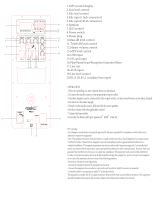 Electron X PROI User manual
Electron X PROI User manual
-
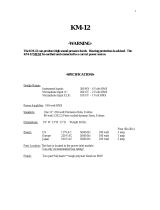 Motion Sound KM-12 Owner's manual
Motion Sound KM-12 Owner's manual
-
Kustom Sienna 65 PRO User manual
-
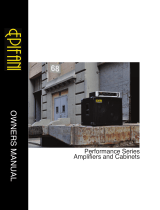 Epifani 502 Owner's manual
Epifani 502 Owner's manual
-
 Acoustic Image New Yorker 420 CA Owner's manual
Acoustic Image New Yorker 420 CA Owner's manual
-
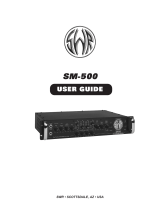 SWR Sound SM-500 User manual
SWR Sound SM-500 User manual
-
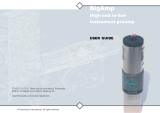 TritonAudio BigAmp User manual
TritonAudio BigAmp User manual
-
Eden E300 Owner's manual
-
Peavey IP-1 Owner's manual
-
UDG 4500635 Datasheet













